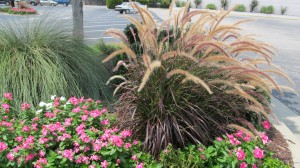Fountain grass (Pennisetum setaceum ) is a warm season grass native to Northern Africa (USDA zones 8-10). It is a dense clump-forming grass with several topnotch cultivars. Most popular are purple fountain grasses (varieties ‘Purpureum’ and ‘Rubrum’) for their heat resistant dark reddish purple foliage. The pink to purplish pink foxtail plumes (flowers) rise above the dark colored foliage starting in mid-summer into early fall. Fountain grass averages 3-4 feet in height and 2-3 feet in spread. Some cultivars grow taller and wider.
Fountain grass is the most popular annual grass planted in the Southern Appalachian gardens (USDA zones 6 and 7). It flourishes in full to partial sunlight (6-hours minimum) in average well-drained soils. Foliage and plume colors are more intense in full sun. P. setaceum is more drought tolerant than the “other” fountain grass (P. alopecuriodes), native from eastern Asia and west Australia.
Spring planted fountain grasses establish rapidly and tolerate short dry spells in summer. Weekly irrigation is your best bet. Fertilize at planting time with a 5-6 month rated slow release fertilizer or feed monthly with water soluble Miracle-Gro™, Schultz®, or a comparable product according to package rates.
Warm season grasses turn shades of brown as the weather turns colder in late fall. Snow or ice encrusted ornamental grasses can be quite beautiful. You may opt to shear them back in early fall, as old floral heads (plumes) tend to self-seed.
Fountain grasses stand out mixed with other perennials, by themselves in enmass, or in planted in containers. They’re mostly disease and pest free as well as deer resistant.


 Posted in
Posted in 
